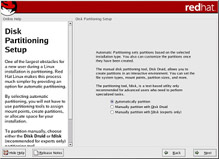Disk Partitioning Setup
|
Partitioning allows you to divide your hard drive into isolated sections where each section behaves as if it were its own hard drive. Partitioning is particularly useful if you run more than one operating system. If you are not sure how you want your system to be partitioned, read Appendix D for more information.
On this screen, you can choose to perform automatic partitioning or manual partitioning using Disk Druid or fdisk (see Figure 2-12).
Automatic partitioning allows you to perform an installation without having to partition your drive(s) yourself. If you do not feel comfortable partitioning your system, it is recommended that you do not choose to partition manually and instead let the installation partition for you.
To partition manually, choose either the Disk Druid or fdisk (recommended for experts only) partitioning tool.

Figure 2-12. Disk Partitioning Setup
| Warning | The Red Hat Update Agent downloads updated packages to /var/spool/up2date by default. If you partition the system manually and create a separate /var partition, be sure to create the partition large enough to download package updates. |
If you chose to manually partition using Disk Druid, see the “Partitioning Your System Manually” section later in this chapter.
If you chose to manually partition using fdisk, see the “Partitioning with fdisk” section later in this chapter.
|
EAN: N/A
Pages: 223